When you visit an exhibition labeled "contemporary art," you may see canvases painted in one color and displayed in a showy manner, or works that were cut into pieces immediately after they were sold at auction and then sold again in pieces for hundreds of millions of yen. ......
Many people may be offended by such seemingly "meaningless" works, which seem to be intentionally trying to mislead the viewer.
In this issue, we will consider how we should deal with contemporary art based on various examples of contemporary art that often give a negative impression.
1. Duchamp, an introduction to "contemporary art" that makes no sense at all
Duchamp's debut
Marcel Duchamp (1887 - 1968) was born into a cultured French family.
He became familiar with painting at an early age, and made his debut as a painter with a work in the style that developed from cubism, Woman Descending a Staircase, No. 02, which depicts a human body in motion. In this painting, the figure of the human body in motion was influenced by the photographs of people such as Edouard Muybridge and Etienne-Jules Mallet, whose works were the talk of the town at the time for their high-speed sequential photographs of moving objects, known as chromatophotography.
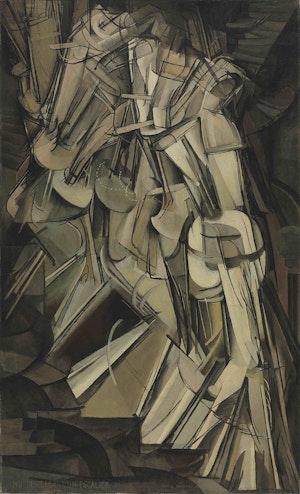
The Impact of "The Fountain" on the World
Duchamp's most famous work is probably "Fountain," published in 1917. This work is considered to be the beginning of modern art, which is often said to be obscure.
Signed simply "R. Mutt" on an overturned male urinal, the work was exhibited at the Society of Independent Artists in New York. Despite the fact that Duchamp himself was a member of the committee, the exhibition was fiercely protested by the artists, who said, "This is not a work of art.
This fact indicates that the tacit understanding that "art should be like this" was common even in the U.S., where abstract art was developing at the time. Duchamp's challenging works destroyed this tacit understanding and further ironized the art world system that "any object can be called art as long as it is titled, signed, and displayed in an appropriate forum.
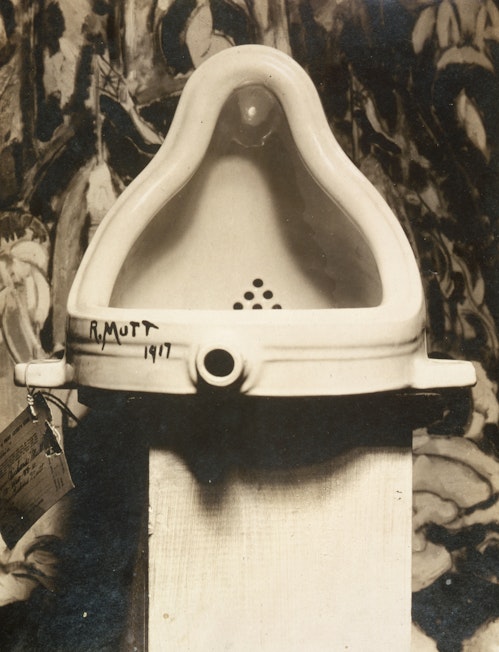
2. the Banksy shredding incident that shocked the world
The Shredding Incident
On October 15, 2018, a print work was auctioned by the global auctioneer Sotheby's. When "Girl with Balloon" appeared in the auction, the final bid was 1,042,000 pounds (approximately 150 million yen), soaring as if to project Banksy's popularity. The final bid was 1,042,000 pounds, which was the second highest bid by Banksy (at the time).
However, the moment the winning bid was announced, an alarm sounded in the hall, and the shredder that had been pre-installed in the frame was activated and began cutting the work into pieces.
The shredded works were carried out of the venue by the staff concerned, while the audience was in an uproar.
Although the shredding was an act of terrorism against the auction business, Sotheby's advertised after the incident that the shredded work was "the first work ever created live during an auction," and the winning bidder paid the winning bid amount to purchase it.
In the end, the criticism itself was incorporated into the auction business, and despite Banksy's own intentions, led to an increase in the market value of the work.
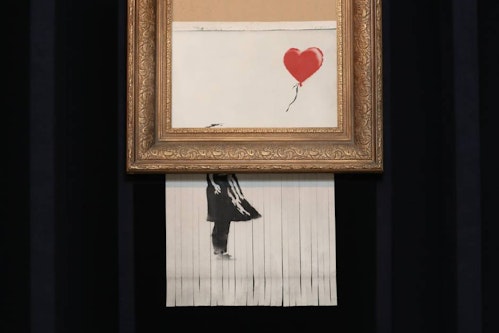
The Impact of the Shredding Incident
Why did Banksy shred his work?
It is said that it was a criticism of the auction business, where only money is accumulated as a speculation target.
Ironically, however, this incident led to an explosion of Banksy's name recognition in Japan.
Why are Banksy's works valued?
Banksy's works are not valued in terms of their aesthetic value or rarity because of his superb technique. Rather, it is his political, presentation, planning, and execution skills that have caused Banksy, and not other artists, to become famous.
In terms of how to communicate an idea to the viewer, Banksy was innovative, even though he used the illegal "graffiti" method.
Column : The focus on art is high. Relationship with Exhibitions and Business
Books on art x business and art as culture are popular
Yamaguchi Shu's "Aesthetic Sense", a bestseller with 170,000 copies sold and also made into a comic book. Why do the world's elite train their "sense of beauty"? Art and Science in Management explains why businesspeople should study art for the solely utilitarian purpose of succeeding in business in a complex and unstable world.

In addition, "The Art of Science" by Koho Suenaga Art Thinking from Age 13: Finding Your Own Answers is a best-selling book that explains "art thinking," which is said to generate "new questions," to a wide audience.

Thus, it is fair to say that there is considerable public interest in how understanding contemporary art can be useful in the field of business, and in "art thinking" as a way of thinking that is on a par with logical thinking, etc. to begin with.
The number of visitors to art services for collectors and exhibitions of contemporary art is on the rise. Combined with skillful marketing, the "Chiharu Shiota: Souls in Motion," held at the Mori Art Museum in 2019, recorded a total of 670,000 visitors.
This is a remarkable figure for a contemporary art exhibition that deals with an active artist as opposed to one that attracts a fixed audience, such as a museum.
3. the beginning of abstract art. Malevich's square painting.
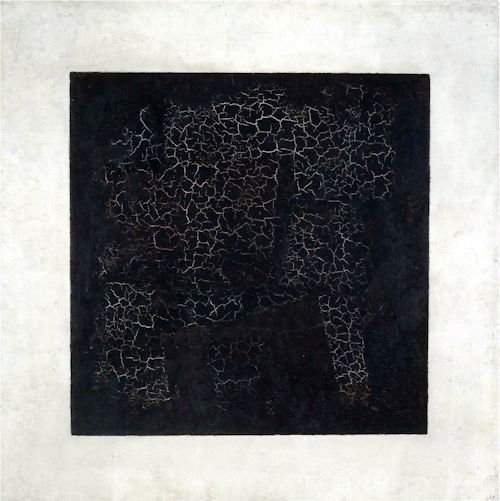
Kazimir Malevich, who presented this work, was a Soviet painter in 1920.
Malevich was creating stage design for a Futurist opera production. Futurism was the name of an avant-garde art group whose works were very avant-garde, consisting of meaningless words, unconnected plots, and dissonant background music.
Malevich, who at the time believed that "new art must be non-objective," also held that the absolute value of this stage art was not to depict any particular scenery or figures, but something abstract and geometric. Malevich called it "absolutism = suprematism," and produced paintings in which elements were reduced to the utmost limit.
The mere "black square" does not represent anything, but exists only as a "black square. The absoluteness of the painting is connected to the iconic absolutism of the Russian Orthodox Church, which is tied to the location of the room where this work was first exhibited, a corner of the ceiling.
The painting, simplified to the extreme, fit with the Orthodox tradition, which abhors idolatry, and moreover, it fit with the period in art history when abstract expression appeared in a fitting manner. It was in this context that Malevich was appreciated. 4.
John Lennon's wife, Yoko Ono, was also a contemporary artist.

Yoko Ono was one of the artists considered part of the avant-garde art movement called Fluxus. Although she may be best known as John Lennon's wife, she herself attracted attention for her avant-garde works, especially performance art.
Her monograph entitled "Grapefruit Juice," a curious book composed of surrealistic imperatives, was published in 1964. It is a special form of artwork in which abstract or very concrete acts are only completed when the reader's imagination is used.
Since that time, she has often received the response, "I don't understand it," but in her own words, the inspiration for her work is "the act of confronting the self.
In one of her works, a large stepladder is placed in the center of the gallery, and if you climb up on it and look up with a magnifying glass, you can read the word "YES" written in very small letters on a painting on the ceiling.
This work was also the first work by Yoko Ono that John Lennon saw, and it has both a very positive and upbeat message and an innovative presentation that is not limited to conventional paintings. 5.
5. the controversial Joseph Kosuth chair
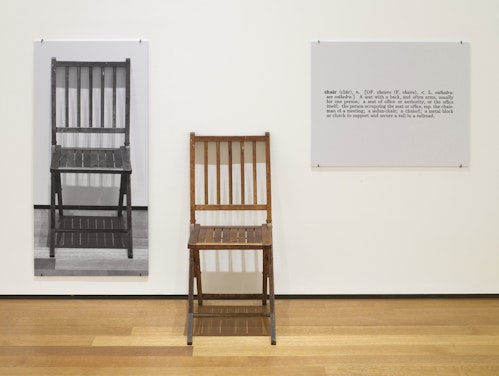
Joseph Kosuth's "One and Three Chairs," a work that displays three items together: a chair, a photograph of the chair, and an enlarged dictionary entry for the word "chair," was exhibited in 1965.
The work was intended to bring the idea of "chair" (a concept according to the ancient Greek philosopher Plato) to life by giving form to it in three different ways.
In other words, it presented the idea of an object, which is usually captured only in visual images, through language, images, and materials, by intertwining them with semiotics and semantics.
It can be said that Kosuth's works were able to raise intellectual issues in a way that is not typical of paintings, as one might imagine from the term "art.
What are the criteria for judging the value of art?
The standard of value of contemporary art tends to be thought of as something difficult or deliberately unfamiliar.
There, although seemingly pedantic, they actually conceal the artist's own sincere thoughts and serious issues about history and human beings.
Some people submit it as it is, while others wrap it up with some other element and submit it.
Sometimes they all look the same from the outermost viewpoint or just seem difficult, but if you look at them with interest, such as by carefully reading the museum's explanation, you will be surprised to find that they often contain a simple message.
I want to read them together.
Contemporary art is said to be meaningless. How do you see it?
Contemporary art is trash! What is the line between a work of art and garbage?
What is contemporary art in the end? The more you know, the more interesting it is!
View TRiCERA ART's latest artworks
TRiCERA ART members receive a variety of benefits and preferences.
- Discounts such as members-only secret sales and coupons
- Create My Collection by registering your favorite artists
- Receive updates on popular artists, exhibitions, and events
- Receive a weekly newsletter with selected art
- Personal Assessment to find out what kind of art you like.
Please register as a member for free and receive the latest information.
Free Member Registration